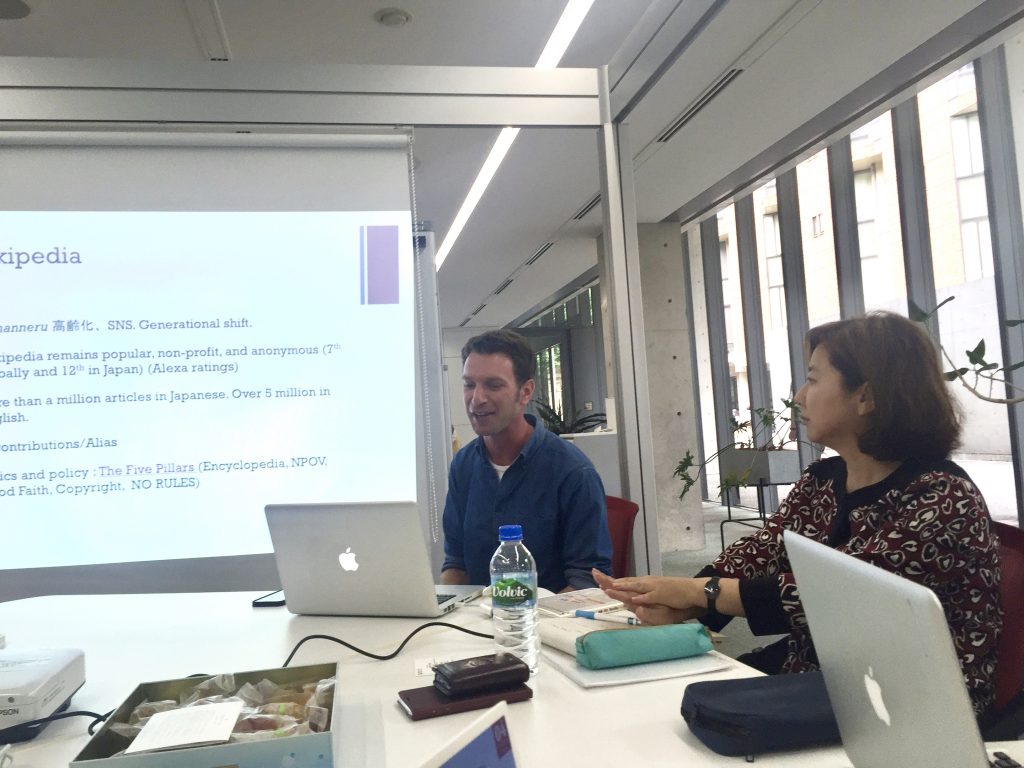In the afternoon of June 16, we hold the Biotope Salon with the speaker Mr. Omri Reis, PhD candidate of the University of Tokyo. His speech was the outline of his doctoral dissertation. Here is the abstract.

Research on multiple editions of the online encyclopedia, Wikipedia, shows significant correlation between news events and patterns of participation on the site (Lih, 2004. Keegan, 2013). The Japanese edition is no different in this regard, with news events, and related articles, receiving more views and edits. However, the Japanese edition, and the community of volunteers operating it clearly exhibit aspects of Japanese web culture, dynamics and modes of interaction.
Wikipedia has been discussed as an example of “the Wisdom of Crowds” (Surowiecki, 2004), or “collective intelligence” (Levi, 1997), where as the Japanese term became shūgōchi(集合知). Unlike the more traditional term shūchi (衆知) which implies a notion of “common knowledge” shared by everyone, shūgōchi implies technical aggregation of information in order to assemble comprehensive and accurate knowledge. Others in Japan have also used the term IA (intelligence amplification) (Nishijima, 2015).
In Japanese historiographies of the Internet, one can easily notice an emphasis on the “uniqueness “of the Japanese Web. In post-bubble 1990s Japan, the preposition suggests, the Internet fostered a culture of cynicism and conservatism. Used predominantly by young, unemployed or marginalized communities, the Web was conceived as a technological means to escape reality rather than to transform it. Social interaction online was mostly anonymous, and supported the free-flow of non-branded information. Critics claim that “profit hatred” (嫌儲), clear separation of the online sphere from “real life” (リア充), “copy” or “sharing” culture (コピー) and flaming dynamics (炎上) are the characteristics that made Japanese online communities unique from a global perspective (Kawakami, 2015; Sasaki, 2015). In this environment, some argue, sustaining Wikipedia’s “good faith” culture (Reagle, 2010) is a challenging endeavor.
Statistical evidence from Wikipedia corroborates many of these assumptions. First, the topical expansion of the Japanese edition leans more towards popular culture than other editions with articles on animation, music and TV getting far more edits and views (Yasseri, et al., 2014). Second, anonymous (or IP based) edits are more common on the Japanese editing than any other major edition. Third, discussion on the “talk” pages is Japan is in most cases shorter than other editions. And lastly, Japanese law stipulates strict restrictions on privacy (in articles on criminal cases for example), and different copyright laws (GFDL applies, but the “fair use” clause mostly does not).
The Japanese web user is also much more on the move than users in other countries. As research from the Japanese Ministry of Internal Affairs and Communications indicates, Japanese users access the Internet from mobile devices, and use mobile applications much more than PC or web browsers. This has a lot to do with long commuting times (about 2 hours, on average, a day in the Kanto area for example), and the popularity of train travel. Since editing Wikipedia from a PC browser is favorable (in terms of convenience and verity of options), passive consumption of information is more prevalent in general, but also in the case of Wikipedia.
However, all of these obstacles do not stop articles on news events from being exceptionally popular both in edits and views. In my talk, I showed how a “trace ethnography” method (Geiger and Ribes, 2011) could be used to see the rich discussion on news events and their subsequent construction into news-based knowledge. Relying on Wikipedia policies and guidelines, Japanese users apply “cleanup tags” to direct the expansion of articles. In the discussion on the Japanese Supreme Court ruling on separate family names for married couples, for instance, Japanese users sought a global comparative view by attaching the “too Japanocentric” cleanup tag. In other examples, I’ve shown how specific media sources (daily national newspapers for example), are preferred by editors on Wikipedia more than others (weeklies, websites). Every month, as Wikipedia’s Zeitgeist statistic shows, news related articles are among the top 10 most edited ones.
News work on the Japanese Wikipedia shows how pseudonymous, or anonymous, online communities are able to sort and filter information into contextual knowledge on current events. In Japan, where open participation is still associated with trolling, or abusive online behavior, it also exemplifies that ethical online collaboration is indeed possible in certain cases. Moreover, in a country that still exhibits extremely low user participation in the news industry, it serves as a model negotiating Japan’s anonymous web culture with a potentially sustainable one for collaborative journalism.
Citations
Geiger, R. Stuart, and David Ribes. “Trace ethnography: Following coordination through documentary practices.” In System Sciences (HICSS), 2011 44th Hawaii International Conference on, pp. 1-10. IEEE, 2011.
Kawakami, Nobuo (ed.) Netto ga unda bunka: dare mo hyōgensha no jidai (Net-borne Culture: The Age when Everybody Speaks). Tokyo: Kadokawa Gakugei, 2015.
Keegan B (2013) “A History of Newswork on Wikipedia”, In WikiSym ’13 Proceedings of the 9th International Symposium on Open Collaboration, Hong Kong, China, 5–7 August, pp. 7:1– 7:10. New York: ACM. Available at: http://doi.acm.org/10.1145/2491055.2491062 [accessed 14 January 2014].
Lévy, Pierre. Collective intelligence. Plenum/Harper Collins, 1997.
Lih, Andrew. “Wikipedia as participatory journalism: Reliable sources? Metrics for evaluating collaborative media as a news resource.” Nature, 2004.
Nishijima, Taooru (ed.) Yuzā ga tsukuru chi no katachi: shugōchi no shinka (the “wisdom” created by users: deepening the wisdom of crowds). Tokyo: Kadokawa Gakugei, 2015.
Reagle, Joseph Michael. Good faith collaboration: The culture of Wikipedia. MIT Press, 2010.
Sasaki, Toshinao. Netto genron kūkan keisei (The formation of the Web’s public sphere). In: Kawakami, Nobuo (ed.) Netto ga unda bunka: dare mo hyōgensha no jidai (Net-borne Culture: The Age when Everybody Speaks). Tokyo: Kadokawa Gakugei, 2015.
Yasseri, Taha, Anselm Spoerri, Mark Graham, and János Kertész. “The most controversial topics in Wikipedia: A multilingual and geographical analysis.” in Global Wikipedia: International and Cross-Cultural Issues in Online Collaboration, Fichman P., Hara N., eds., Scarecrow Press, 2014.
Available at SSRN:http://ssrn.com/abstract=2269392 or http://dx.doi.org/10.2139/ssrn.2269392
(Omri Reis, PhD Candidate, GSII, UTokyo)